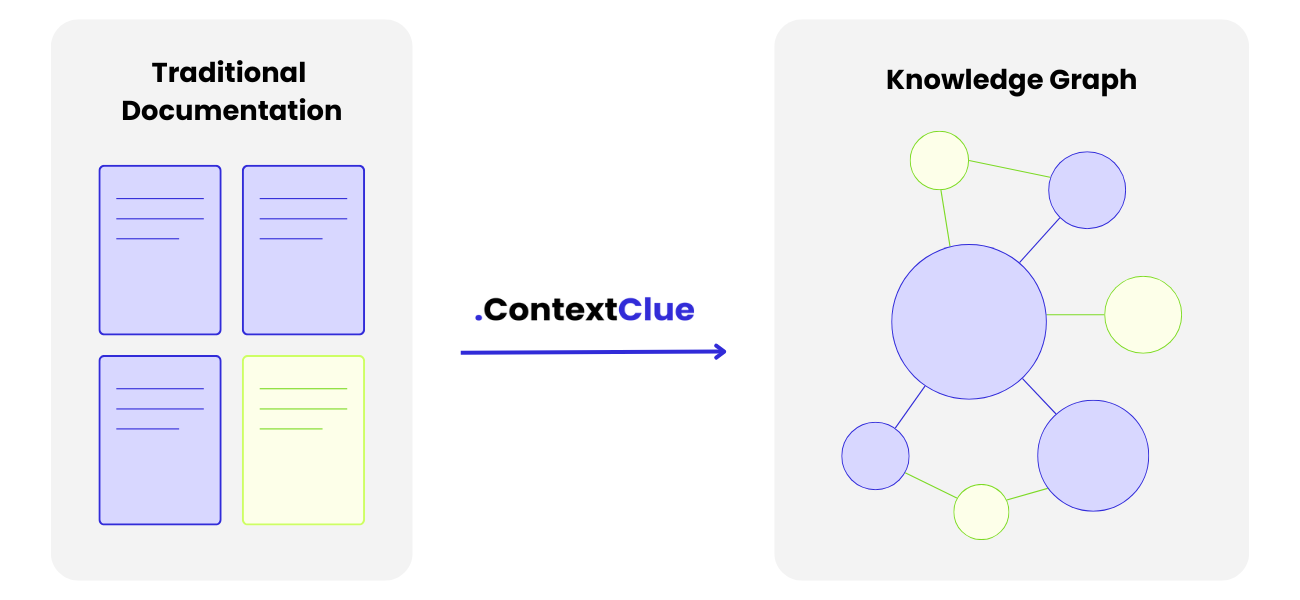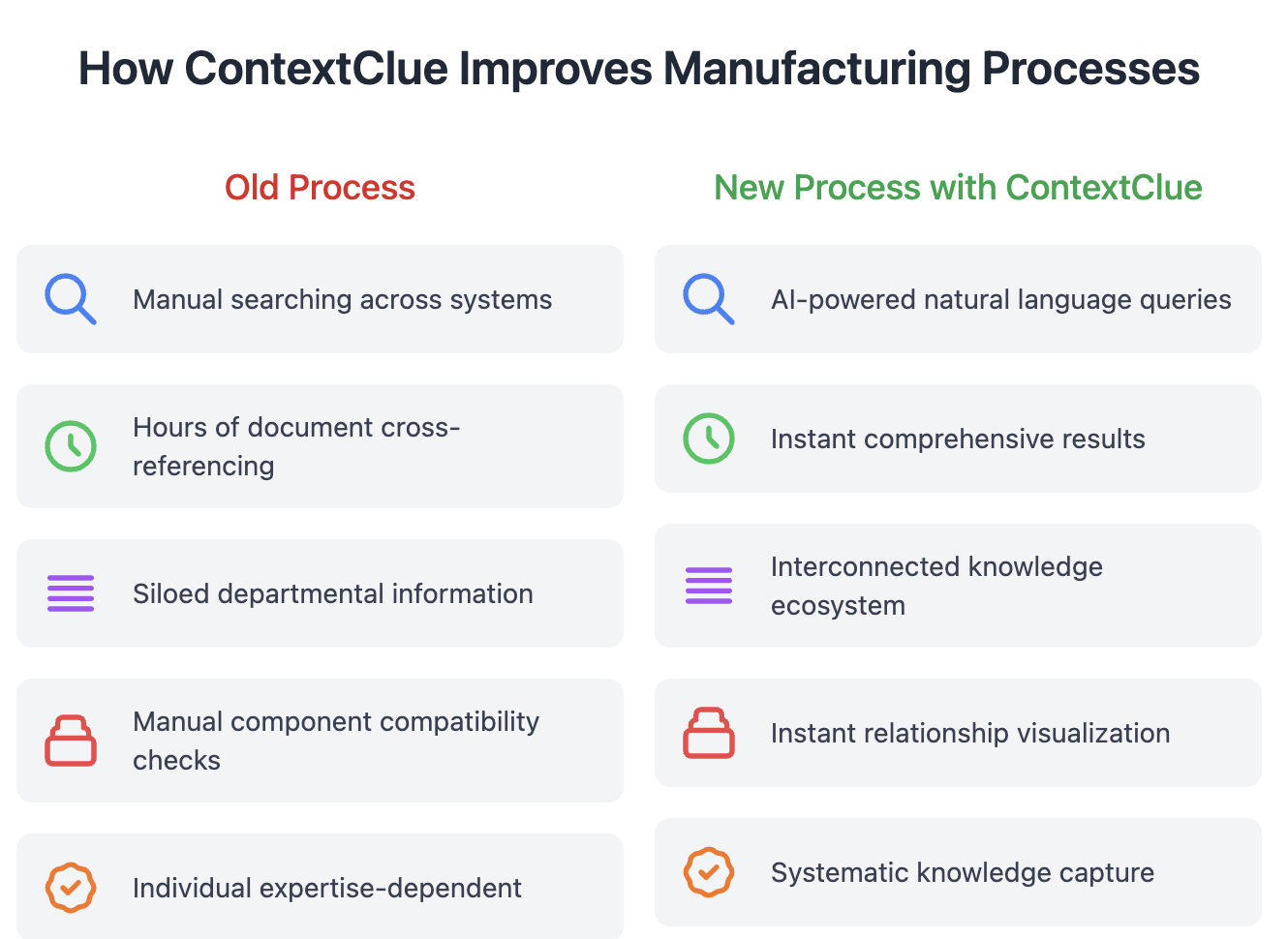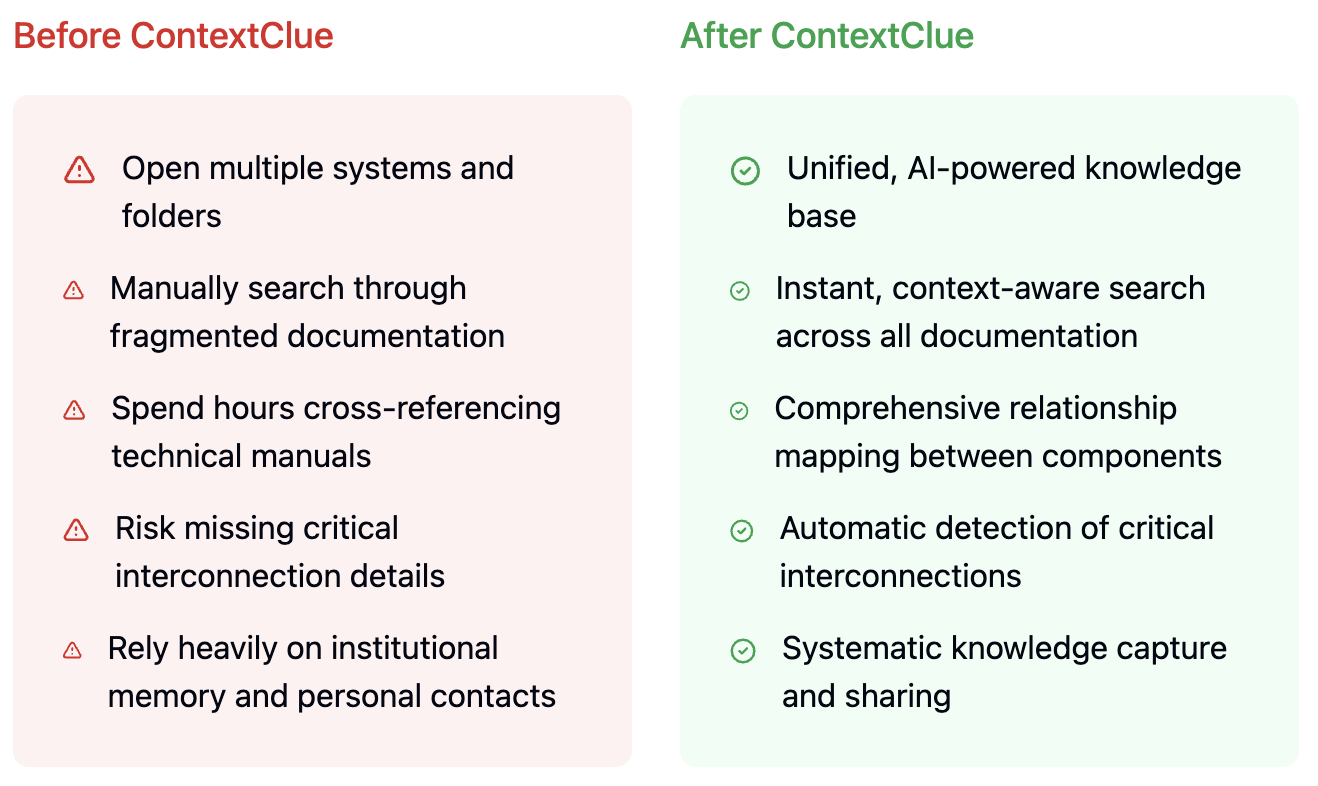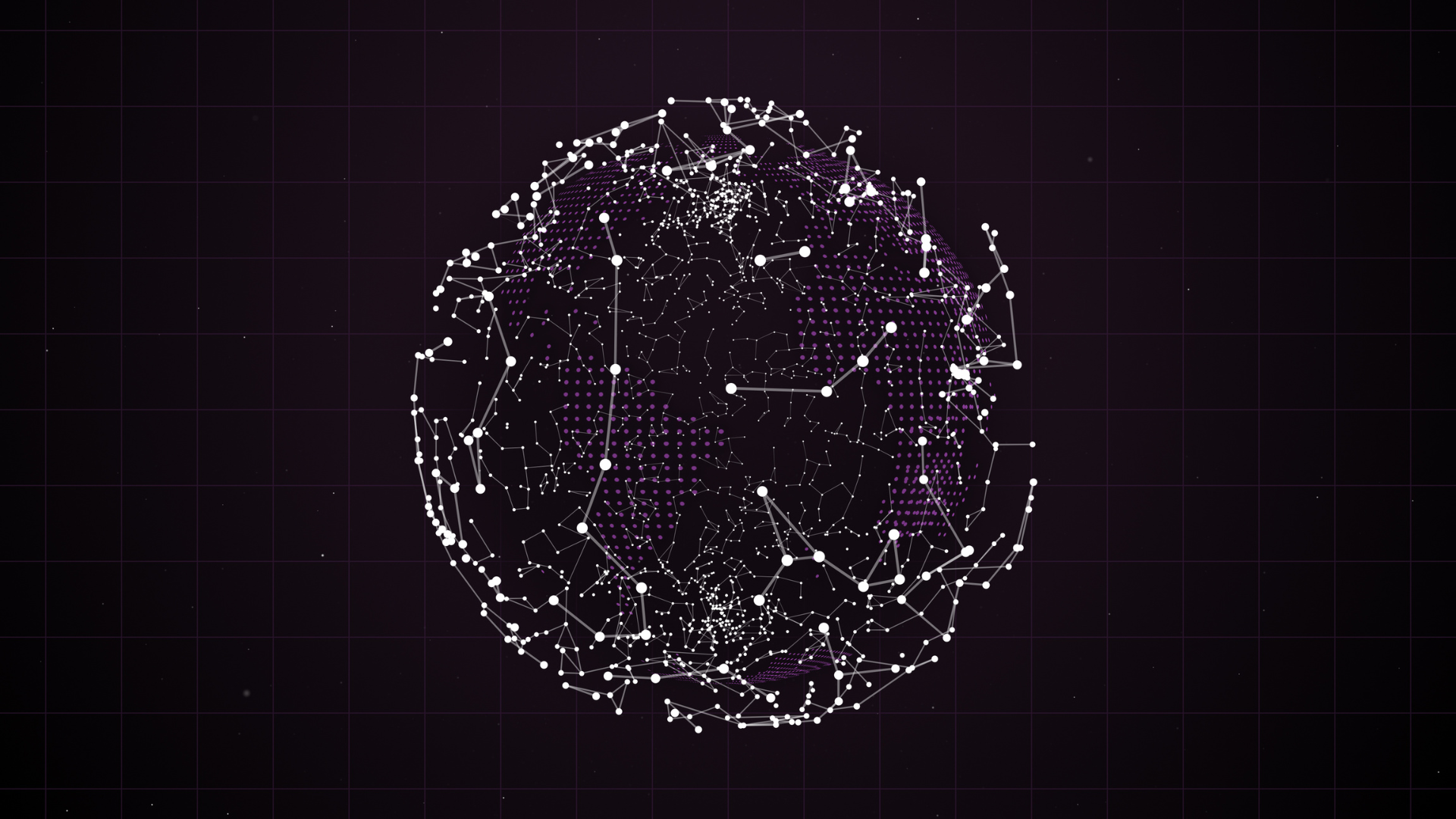
May 07, 2025
The Power of Knowledge Graphs in Managing Complex Technical Documentation
Author:

CSO & Co-Founder
Reading time:
11 minutes
Organizations across industries are discovering that engineers and technical professionals spend significant time searching for information scattered across disconnected systems. This inefficiency hampers productivity and slows innovation in environments where rapid development and problem-solving are essential competitive advantages.
The Technical Documentation Challenge
Modern industrial operations involve intricate networks of systems, components, and processes – from robotic production lines and control units to software systems and precision engineering documentation. As technical complexity increases, traditional approaches to documentation management face significant limitations:
- Information silos: Critical knowledge trapped in disconnected repositories
- Limited searchability: Difficulty finding specific information within large document sets
- Missing context: Inability to see relationships between components and systems
- Static documentation: Failure to capture the dynamic nature of technical relationships
- Knowledge fragmentation: Critical insights scattered across multiple formats and systems
In an era demanding rapid innovation and lean operations, these limitations represent a substantial barrier to efficiency and competitive advantage.
Knowledge Graphs: A Transformative Approach
Knowledge graph technology offers a revolutionary solution to these complex challenges. Unlike traditional databases that store information in rigid tables with implicit relationships, knowledge graphs represent information as nodes (entities) connected by labeled, explicit relationships.
This approach allows for a more natural and flexible modeling of complex dependencies between components, systems, and documents, creating an interconnected knowledge ecosystem that transforms how technical information is stored, accessed, and utilized.

Core Components of a Technical Documentation Knowledge Graph
Entities: Represent discrete elements in the technical domain:
- Physical components and systems
- Documents and specifications
- Processes and procedures
- People and organizational units
Relationships: Define how entities connect:
- “is part of” (component hierarchy)
- “connects to” (system integration)
- “is documented in” (knowledge location)
- “is compatible with” (interoperability)
Properties: Describe attributes of entities and relationships:
- Technical specifications
- Temporal information (creation date, revision history)
- Authorship and ownership
- Status information
How Knowledge Graphs Transform Technical Documentation
1. Automated Relationship Mapping
Knowledge graphs automatically identify and represent connections between technical components, systems, and documentation across multiple repositories. This creates a comprehensive map of the technical ecosystem, making previously implicit relationships explicit and discoverable.
For example, when a production system includes a specific robotic component, the knowledge graph can automatically link:
- The component’s technical specifications
- Maintenance procedures
- Compatible systems
- Historical performance data
- Subject matter experts
2. Semantic Understanding
Through advanced natural language processing and machine learning techniques, knowledge graph systems transform unstructured technical documents into a navigable, meaningful network. The system understands not just keywords but concepts and their relationships, enabling more intelligent information retrieval.
For instance, a search for “cooling system failure” would identify not just documents containing those exact words, but also related concepts like “temperature regulation malfunction” or “heat dissipation issues.”
3. Context-Aware Search
Engineers and technical professionals can find precise information through natural language queries that understand intent and context. Rather than simple keyword matching, knowledge graph-powered search understands the semantic meaning behind queries.
A technician could ask, “What are the torque specifications for mounting the control unit on assembly line B?” and receive precise answers drawn from across the knowledge ecosystem – without having to know which specific document contains that information.
4. Dynamic Visualization
Interactive visualization of technical relationships and dependencies transforms complex systems into intuitive, navigable maps. Users can visually trace connections between components, identify potential integration challenges, and discover related documentation.
This visual approach is particularly valuable for understanding complex systems with numerous interdependencies, allowing engineers to “see” the relationships between various components and quickly identify potential issues.
Building a Technical Documentation Knowledge Graph
The process of building and utilizing a knowledge graph for technical documentation involves several key stages:
1. Knowledge Discovery and Extraction
- Source identification: Locating and accessing all relevant document repositories and data sources
- Intelligent document processing: Extracting structured information from unstructured documents
- Entity recognition: Identifying key components, systems, and concepts
- Relationship extraction: Determining how entities relate to one another
2. Knowledge Graph Construction
- Ontology development: Creating a formal representation of the domain’s concepts and relationships
- Graph database implementation: Storing entities and relationships in a specialized database optimized for graph operations
- Continuous integration: Building automated pipelines to update the graph as new information becomes available
- Quality assurance: Validating the accuracy and completeness of the knowledge representation
3. Integration and Visualization
- System connection: Integrating with existing enterprise systems (PLM, ERP, CAD)
- User interface development: Creating intuitive ways to interact with the knowledge graph
- Visual exploration tools: Enabling the visualization of complex relationships
- Query capabilities: Developing natural language interfaces for information retrieval
4. Artificial Intelligence Enhancement
- Large Language Models (LLMs): Leveraging advanced AI to understand complex technical queries
- Natural Language Processing (NLP): Processing text to extract meaning and intent
- Machine Learning: Continuously improving the system based on usage patterns
- Knowledge inference: Discovering new relationships not explicitly stated in the documentation
The Role of Large Language Models in Knowledge Graphs
Large Language Models (LLMs) have significantly enhanced the capabilities of knowledge graph systems for technical documentation. These AI models serve several critical functions:
- Natural language understanding: Interpreting complex technical queries and translating them into precise graph operations
- Information extraction: Identifying entities and relationships in unstructured text
- Knowledge graph navigation: Traversing the graph to find relevant information
- Answer generation: Synthesizing information from multiple sources to create coherent responses
- Context maintenance: Understanding the user’s intent across multiple interactions
The combination of knowledge graphs and LLMs creates a powerful system that can understand technical questions, navigate complex information landscapes, and deliver precise answers in natural language—transforming how engineers and technical professionals interact with documentation.
Transforming Technical Work
By implementing knowledge graph technology for technical documentation management, organizations fundamentally transform how technical work is performed:
- From searching to finding: Engineers move from manually hunting for information to immediately accessing precisely what they need
- From fragmentation to integration: Disconnected documents become a cohesive, interconnected knowledge ecosystem
- From static to dynamic: Documentation evolves from static files to living knowledge that reflects the current state of systems
- From implicit to explicit: Hidden relationships become visible, navigable connections
- From information to insight: Raw data becomes actionable knowledge that drives better decisions
Challenges in Implementing Knowledge Graph Solutions
While knowledge graphs offer tremendous potential for transforming technical documentation management, organizations should be aware of several challenges they may encounter during implementation:
1. Data Quality and Integration Issues
The effectiveness of a knowledge graph depends heavily on the quality and completeness of the data it contains. Organizations often face challenges with:
- Inconsistent terminology across different documentation sources
- Incomplete or outdated information in legacy systems
- Varying data formats and structures that complicate extraction
- Manual documentation practices that don’t follow standardized formats
These issues require significant data cleaning, normalization, and enrichment efforts before a truly valuable knowledge graph can be established.
2. Ontology Development Complexity
Creating an effective ontology—the conceptual framework that defines entities and relationships within the knowledge graph—requires deep domain expertise and careful planning:
- Domain experts and knowledge engineers must collaborate closely
- Industry-specific terminology and relationships need precise definition
- The ontology must be flexible enough to evolve with changing technical systems
- Finding the right balance between specificity and generality is challenging
Organizations often underestimate the complexity and time required for proper ontology development, which can delay implementation and reduce initial value.
3. Technical and Resource Requirements
Building and maintaining a knowledge graph system requires significant technical resources:
- Specialized expertise in graph databases and semantic technologies
- Computational resources for processing large document collections
- Integration capabilities with existing enterprise systems
- Ongoing maintenance and updating mechanisms
Smaller organizations may find these requirements prohibitive without strategic planning and resource allocation.
4. Change Management and Adoption
Perhaps the most significant challenge lies not in the technology itself but in driving organizational adoption:
- Technical professionals must shift from familiar documentation practices
- Training is required to effectively utilize new search and visualization capabilities
- Workflows need to be redesigned to incorporate knowledge graph interactions
- Return on investment may take time to materialize, requiring sustained commitment
Without effective change management strategies, even the most technically advanced knowledge graph solution may fail to deliver its potential value.
5. Balancing Automation and Human Expertise
While AI and machine learning can automate much of the knowledge extraction process, human expertise remains essential:
- Subject matter experts must validate extracted relationships
- Edge cases often require human judgment to resolve
- Domain-specific nuances may be missed by automated systems
- The “human in the loop” aspect must be carefully designed for efficiency
Organizations need to find the right balance between automation and expert involvement to build and maintain high-quality knowledge graphs.
Successfully navigating these challenges requires a phased approach, realistic expectations, and a focus on high-value use cases that can demonstrate immediate benefits while building toward a comprehensive knowledge ecosystem.
Case Study: ContextClue’s Knowledge Graph Solution
The Challenge: Technical Knowledge Management
Organizations across industries face a common challenge: engineers and technical professionals spend up to 20% of their valuable time searching for information scattered across disconnected systems. This inefficiency hampers productivity and slows innovation in environments where rapid development and problem-solving are essential competitive advantages.
Modern industrial operations involve intricate networks of systems, components, and processes—from robotic production lines and control units to software systems and precision engineering documentation. Traditional documentation management approaches face significant limitations:
- Information silos with critical knowledge trapped in disconnected repositories
- Limited searchability within large document sets
- Missing context between components and systems
- Static documentation that fails to capture dynamic technical relationships
- Knowledge fragmentation across multiple formats and systems
The Solution: ContextClue’s Knowledge Graph Approach
ContextClue addresses these challenges by transforming fragmented technical documentation into a unified, searchable knowledge system.

At its core is the creation and utilization of a knowledge graph that represents information as nodes (entities) connected by labeled relationships—allowing for more natural and flexible modeling of complex dependencies between components, systems, and documents.
Knowledge Discovery and Extraction
ContextClue identifies key document repositories and data sources, using intelligent document processing to extract structured information. The system employs advanced techniques including semantic and structural analysis to identify entities (such as part names and machine types) and the relationships between them (such as “is part of” or “connects to”).
By integrating information from various sources—including CAD drawings, technical manuals, production line specifications, and legacy documents—ContextClue creates a comprehensive digital representation of the manufacturing ecosystem.
Knowledge Graph Construction
The system builds a central knowledge graph with the identified entities and relationships through automated knowledge extraction pipelines. This graph is continuously updated as new documents and data are added, creating a living representation of the technical environment.
Integration and Visualization
ContextClue connects the knowledge graph to existing systems (PLM, ERP, CAD) and virtual commissioning software. Engineers access this unified knowledge through visual exploration interfaces and natural language query capabilities.
Real-World Impact of ContextClue Implementation
Engineers can instantly trace component relationships, identify potential configuration conflicts, and access critical information across previously disconnected systems. They can simply ask natural language queries like “Find all specifications for robotic arm X” and immediately receive comprehensive information—including technical details, maintenance history, compatibility information, and potential integration challenges from across multiple systems.
Instead of navigating through countless folders, email chains, and disconnected systems, technical professionals gain an intuitive, interconnected view of their entire technical ecosystem. A technician troubleshooting a specific component can instantly visualize its relationships with other systems, understand potential failure points, and access precise maintenance procedures—all through a single, intelligent interface.
Long-term Transformation
This technological leap means engineers can redirect their time and expertise from administrative document hunting to high-value problem-solving and innovation. The dynamic visualization transforms complex system dependencies into transparent, easily navigable networks, significantly reducing the risk of configuration errors and enabling more informed decision-making across the entire production process.
As stated in the broader industry analysis, organizations implementing knowledge graph technology for technical documentation can experience:
- 80% reduction in time spent searching for technical information
- Faster troubleshooting of production line issues
- Improved quality through better access to specifications and standards
- Enhanced compliance with regulatory requirements
- Streamlined maintenance procedures
- Reduced risk through better visibility of system interdependencies
By implementing ContextClue’s knowledge graph solution, organizations transform information from a potential bottleneck into a strategic asset that accelerates innovation, enhances quality, and drives competitive advantage in an increasingly complex technical landscape.

Conclusion: LLM-powered Knowledge Graphs in Tech Knowledge Management
While knowledge graphs are not a new concept in manufacturing and have long been used to structure and connect technical information, their integration with large language models marks a significant advancement. What once required extensive manual effort can now be generated and maintained automatically, drastically improving scalability and efficiency. This evolution transforms knowledge graphs into dynamic, intelligent systems that make technical documentation more accessible and actionable.
As engineering systems grow increasingly complex, the ability to quickly navigate vast technical resources becomes essential. LLM-enhanced knowledge graphs empower engineers and technical teams to retrieve relevant information with ease, allowing them to focus more on innovation and problem-solving rather than information retrieval.
Organizations that adopt this next-generation approach to knowledge management stand to unlock greater operational efficiency and convert their technical know-how into a true strategic asset in an intensely competitive global environment.
Category:






